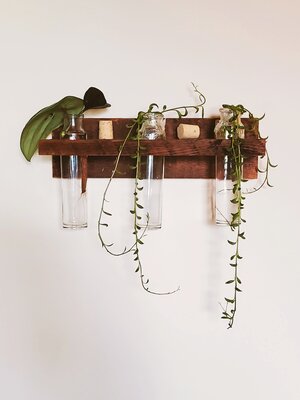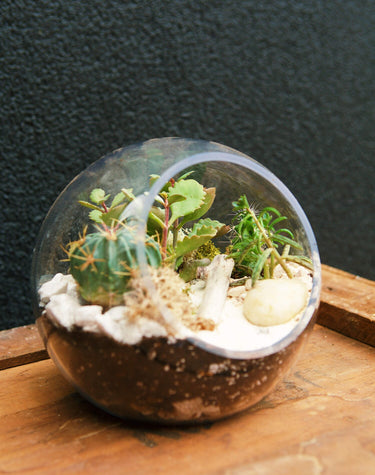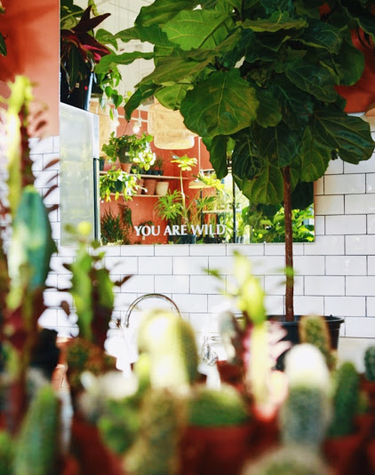
What is a propagation station?
I didn’t know anything about propagation the first time I took a clipping. I was killing my (or at least my partner’s) first succulent; it was leggy and droopy, but it still had a perfect rosette on top. I clipped the succulent, peeled off some leaves and shoved them into some dirt with very low expectations. I was thrilled when my propagates began to grow, and I began to explore other possibilities.

What is propagation?
Propagation is breeding a plant from a larger plant, or parent stock. The process requires a clipping from the original plant, the right rooting technique, and patience. Though there are many methods, plant lovers typically propagate their stems in water or soil. Given time, your propagates will produce roots, and then you can pot your new plant!
A propagation station is a designated home for your propagates, and mine helps me check on and care for clippings easily. I like to propagate in water because I like watching roots develop, but the technique is mostly determined by the type of plant that I’m growing. When propagating, it is important to remember that every plant is different and that what works for one plant might not work for another. For example, most plants propagate from a clipping with a node, which is where the leaf meets the stem of the plant; however some plants, like begonias and peperomias are capable of growing another plant from a single leaf. It can be helpful to do a little research about how your plant will propagate before getting started.
What plants are easiest to propagate?
Pothos are a popular introduction to propagating because they grow quickly and are easy to root. I've found Tradescantia is the fastest to propagate, and can put out new growth after just days in soil or water.
How long does propagation take?
The time required to propagate varies by plant. Pothos clippings can develop roots within a month, and are ready to pot once the roots are a few inches long. I’ve found most of my cacti clippings took a few months until I noticed significant growth, though my prickly pear cactus grew a new paddle in half the time.
Where should you put your propagates?
My propagate station is mounted 10 feet away from a frosted west-facing window, which gives my clippings many hours of bright, filtered light. I chose this space because most plants propagate best in bright, indirect light. I change the water in each tube every few days. Currently, I’m propagating a raven ZZ plant, a watermelon peperomia, and a few strings of bananas.
The raven ZZ and peperomia did not require nodes; the peperomia is growing from a single leaf, and the ZZ is a small cutting from a stalk. The ZZ has been in water for at least 3 months, and the peperomia has been propagating for about a month.


I use a slightly different method when I root succulents in water, which is only something I do for the “strings” succulent family. After putting water in the tube, I covered the opening with 2 layers of plastic wrap. I then poked holes in the plastic wrap with a toothpick so my cuttings would be able to root in water without wetting the leaves. Before I started using plastic wrap as a barrier, my succulent clippings never took because the leaves would rot before roots grew! I have also rooted strings of beads and strings of pearls this way.

There's a special feeling of pride that comes from watching a cutting turn into a flourishing plant, especially once you’re able to take a clipping from the new plant. Whether you’re gifting someone a piece of your plant or just adding to the family, propagation can become an easy, fun plant project.



Leave a comment
This site is protected by hCaptcha and the hCaptcha Privacy Policy and Terms of Service apply.